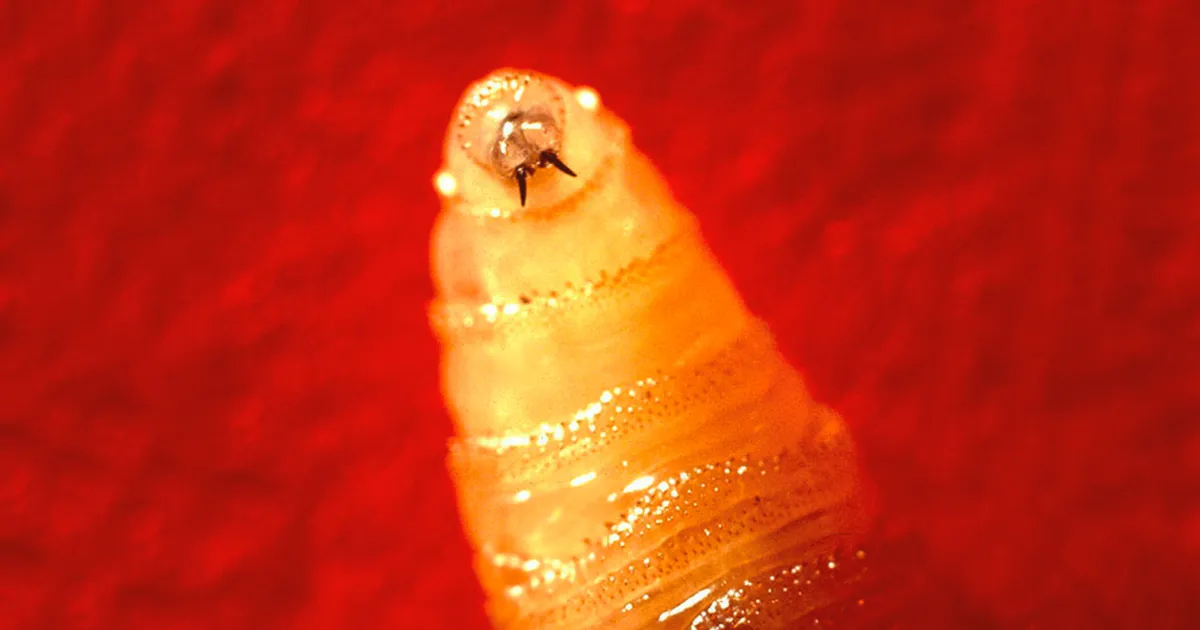As Costa Rica prepares for the upcoming rainy season, parasitologists are sounding the alarm about a potential surge in screwworm cases by the end of 2024. The combination of warm temperatures and increased humidity creates an ideal environment for parasites to thrive, and the screwworm, a particularly dangerous pest, could see a significant rise in numbers if these conditions persist.
Why Rainy Seasons Are a Breeding Ground for Parasites
Victor Montenegro, a parasitologist at the School of Veterinary Medicine of the National University (UNA), explains that in warm climates, rising rain and humidity provide a perfect breeding ground for parasites. “In these conditions, parasite cycles thrive,” he said. Conversely, droughts and extremely cold climates can suppress or even eliminate these parasitic cycles. However, Costa Rica’s tropical climate, combined with the anticipated heavy rains, is expected to contribute to an increase in screwworm cases.
The screwworm (Cochliomyia hominivorax) is a parasitic fly that poses a serious threat to both livestock and wildlife. While upland regions and urban areas aren’t typically the primary habitats for this pest, Montenegro warns that cases in these areas cannot be ruled out due to the fly’s ability to travel long distances. This makes the upcoming months particularly critical for monitoring and controlling screwworm infestations.
The Impact on Livestock and Pets
According to data from the National Animal Health Service (SENASA), screwworm infections have already had a significant impact on Costa Rica’s livestock. Cattle are the most affected, with 75% of cases, which translates to over 3,000 infected cattle. Dogs are the next most affected, accounting for 15% of cases, or nearly 600 animals. Montenegro emphasizes the importance of vigilance, especially for pets that spend extended periods outdoors or stray dogs, which are more susceptible to infection.
The screwworm lifecycle begins when the female fly lays eggs in an open wound on an animal. Within days, the eggs hatch into larvae, or maggots, which then burrow into the flesh, causing severe tissue damage and, if left untreated, can lead to the death of the host. The complete cycle, from egg-laying to the emergence of a new fly, takes about 21 days.
The Risk to Wildlife: A Growing Concern
Veterinarians at UNA are also increasingly concerned about the potential spread of screwworms to wildlife. Wildlife living in protected areas and national parks are particularly vulnerable due to the challenges of monitoring and treatment. Species such as deer, wild pigs, wild cats, and coyotes could be at risk, according to experts.
“The problem is that if cases spread to wild animals, it could spiral out of control,” warns Alexis Sandí from SENASA’s Epidemiology Department. “Detecting and treating screwworm in wild animals is extremely challenging,” he added. The concern is that an unchecked spread among wildlife could lead to a significant ecological impact, as these animals play crucial roles in their ecosystems.
Human Cases: A Growing Threat
While screwworms primarily affect animals, humans are not immune. As of July 31, Costa Rica has reported 22 cases of screwworm myiasis in humans. The Ministry of Health has identified Puntarenas and San José as the provinces with the highest case counts, though all five other provinces have reported at least one case each.
Human screwworm infection, though less common, can be severe. The larvae can infest any open wound, leading to painful and potentially life-threatening conditions if not treated promptly. Given the fly’s extensive flight capabilities and the favorable conditions created by the rainy season, the risk of human cases could rise.
The Lifecycle of a Screwworm: Understanding the Threat
Understanding the lifecycle of the screwworm is key to combating its spread. After mating, the female screwworm fly searches for a warm-blooded host to lay her eggs. She typically chooses an open wound, where she deposits hundreds of eggs. Within a few days, these eggs hatch into larvae, which begin to feed on the host’s tissue. This feeding process can cause severe damage, and if left untreated, the infestation can lead to serious health consequences, including death.
The entire lifecycle of the screwworm, from egg-laying to the emergence of the next generation of flies, spans approximately 21 days. This rapid cycle means that infestations can grow quickly, particularly in conditions that favor the fly’s reproduction.
Preventative Measures and Vigilance: The Way Forward
As Costa Rica heads into what could be a particularly challenging rainy season, authorities and the public alike must remain vigilant. Preventative measures, such as keeping livestock and pets clean and promptly treating any wounds, are essential in reducing the risk of infection. For livestock owners, regular inspections and timely veterinary care can make a significant difference.
SENASA and other organizations are likely to ramp up their efforts to monitor and control the spread of screwworms, particularly in regions identified as high risk. Public awareness campaigns may also be necessary to inform citizens of the dangers and the steps they can take to protect themselves and their animals.
For those in wildlife management, the challenge is even greater. Developing strategies to monitor and, if necessary, treat wild populations without disrupting their natural behaviors will be crucial. This may involve more research into effective and humane methods of control that can be implemented in protected areas.
Facing the Challenge Ahead
The anticipated rise in screwworm cases is a serious concern for Costa Rica as the rainy season approaches. With livestock, pets, wildlife, and even humans at risk, the need for vigilance and proactive measures is more critical than ever. While the conditions may be ideal for the screwworm’s lifecycle, a coordinated response from authorities, veterinarians, and the public can help mitigate the impact and protect both animals and people.

